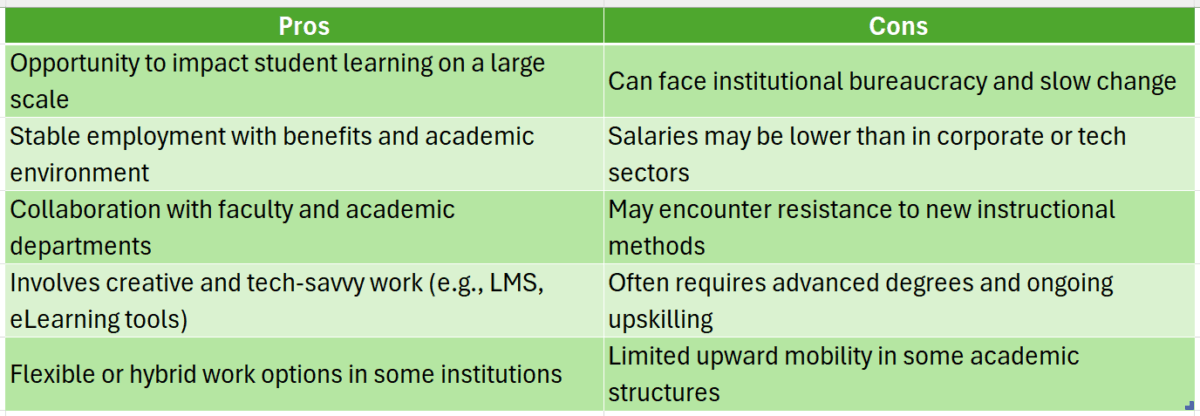
When considering a career in higher education, understanding the role of higher ed instructional design jobs is crucial. These positions are not just about creating courses; they shape the learning experience for students. With the rise of online education, the demand for skilled instructional designers has never been higher.
What Does an Instructional Designer Do?
Instructional designers develop effective learning materials and experiences. They work closely with faculty to create engaging instructional design curriculum that meets students’ needs. This involves:
- Analyzing learning objectives
- Designing course content
- Evaluating the effectiveness of materials
By focusing on these areas, instructional designers ensure that students receive a quality education, whether in-person or online.
Pathways to Enter the Field
To land a job in this field, many candidates pursue an instructional design bachelor’s online. This flexible option allows you to gain the necessary skills while balancing other commitments. Additionally, gaining experience through internships or volunteer work can significantly boost your resume. Remember, networking with professionals in the field can also open doors to exciting opportunities!
Start your journey to a brighter future—Enroll now!
What Skills Are Essential for Instructional Designers in Higher Education?

Landing a job in higher ed instructional design can be exciting and rewarding. But what skills do you need to stand out? Understanding the essential skills can help you tailor your approach and boost your chances of success in this competitive field.
Strong Communication Skills
Instructional designers must communicate ideas clearly. Whether you’re writing an instructional design curriculum or presenting to faculty, being able to express your thoughts is key. Good communication helps you collaborate effectively with others.
Technical Proficiency
Familiarity with various educational technologies is crucial. Knowing how to use learning management systems and design software can set you apart. Many higher ed instructional design jobs require you to be tech-savvy, so keep learning!
Creativity and Problem-Solving
Instructional designers need to think outside the box. Creating engaging learning experiences often involves innovative solutions. Your creativity can make a significant difference in how students learn and interact with the material.
How to Build a Strong Portfolio for Instructional Design Positions
Building a strong portfolio is essential for landing higher ed instructional design jobs. Your portfolio showcases your skills and creativity, making it a vital tool in your job search. It’s not just about having a degree; it’s about demonstrating your ability to create effective instructional design curriculum that meets the needs of diverse learners.
Start with Your Best Work
Begin by selecting your best projects. Include a variety of work that highlights your skills in different areas of instructional design. This could be anything from e-learning modules to classroom materials. Remember, quality over quantity is key!
Showcase Your Process
Don’t just show the final product; explain your process. Include drafts, storyboards, and feedback you received. This helps potential employers see how you think and solve problems. It’s a great way to demonstrate your understanding of instructional design principles learned in your instructional design bachelor’s online program.
Keep It Updated
Finally, always keep your portfolio updated. As you gain more experience and complete new projects, add them to your portfolio. This shows that you are actively engaged in your professional development and ready for new challenges in the field of instructional design.
Networking Strategies to Connect with Higher Ed Professionals
Networking is crucial when seeking higher ed instructional design jobs. Building connections can open doors to opportunities that you might not find through traditional job searches. By engaging with professionals in the field, you can gain insights into the instructional design curriculum and the skills that employers value most.
Attend Conferences and Workshops
Participating in industry conferences and workshops is a fantastic way to meet people. These events often feature sessions on the latest trends in instructional design, allowing you to learn and network simultaneously. Don’t forget to bring business cards to share your contact information!
Join Online Communities
Consider joining online forums or social media groups focused on instructional design. Platforms like LinkedIn are great for connecting with higher education professionals. Engage in discussions, share your knowledge, and ask questions. This can help you build relationships and learn about instructional design bachelor’s online programs that might enhance your qualifications.
Where to Find Job Openings for Instructional Design Roles
Finding the right job in higher education can feel like searching for a needle in a haystack. However, knowing where to look for higher ed instructional design jobs can make all the difference. With the right resources, you can uncover opportunities that align with your skills and passion for creating effective instructional design curriculum.
Online Job Boards
- HigherEdJobs.com: This site specializes in positions within higher education, making it a great starting point.
- LinkedIn: Use LinkedIn to network and search for instructional design roles. Many universities post jobs here.
- Indeed: A broad job search engine where you can filter for instructional design positions in higher education.
University Websites
Don’t forget to check the career pages of universities directly. Many institutions post their job openings exclusively on their own websites. This is especially true for instructional design roles that require specialized skills or an instructional design bachelor’s online.
Crafting a Compelling Resume for Higher Ed Instructional Design Jobs
Crafting a compelling resume is crucial when aiming for higher ed instructional design jobs. Your resume is often the first impression you make on potential employers, so it needs to shine. Highlighting your skills in instructional design curriculum can set you apart from other candidates and show your dedication to the field.
Key Elements to Include in Your Resume
- Relevant Experience: Focus on any previous roles in instructional design or related fields. If you’ve worked on developing an instructional design curriculum, make sure to showcase that experience.
- Education: List your degrees, especially if you have an instructional design bachelor’s online. This shows your commitment to learning and staying updated in the field.
- Skills: Include technical skills like e-learning software, project management, and any specific methodologies you’re familiar with. These are essential for higher ed instructional design jobs.
Tailoring Your Resume
Make sure to tailor your resume for each job application. Use keywords from the job description, especially those related to instructional design. This not only helps your resume stand out but also makes it more likely to pass through applicant tracking systems. Remember, a well-crafted resume can open doors to exciting opportunities in higher education!
Start your journey to a brighter future—Enroll now!
Preparing for Interviews: Tips for Aspiring Instructional Designers
Landing a job in higher ed instructional design can be exciting yet challenging. With the right preparation, you can stand out in interviews and showcase your skills effectively. Understanding the nuances of instructional design curriculum is crucial, as it helps you align your knowledge with the needs of educational institutions.
Know Your Stuff
- Familiarize yourself with the latest trends in instructional design. This includes understanding various learning theories and technologies.
- Highlight your educational background, especially if you have an instructional design bachelor’s online. This shows your commitment to the field.
Practice Makes Perfect
- Conduct mock interviews with friends or mentors. This will help you articulate your thoughts clearly.
- Prepare to discuss your portfolio. Showcase projects that demonstrate your ability to create engaging learning experiences.
- Be ready to answer questions about how you would approach specific instructional design challenges.
The Importance of Continuous Learning in Instructional Design Careers
In the world of higher education, landing instructional design jobs can be competitive. Understanding the importance of continuous learning is crucial for aspiring instructional designers. As technology and teaching methods evolve, staying updated can set you apart from other candidates. Let’s explore why ongoing education matters in this field.
Embrace New Technologies
- Stay Current: New tools and software for instructional design are constantly emerging. Familiarizing yourself with these can enhance your skills.
- Adapt to Trends: Higher ed instructional design jobs often require knowledge of the latest trends in education. Continuous learning helps you adapt and innovate in your curriculum.
Enhance Your Skills
- Online Courses: Consider enrolling in an instructional design bachelor’s online program. These programs often offer the latest insights and techniques.
- Networking Opportunities: Engaging in workshops or webinars can connect you with industry professionals and potential job opportunities.
- Certifications: Earning certifications can boost your resume and demonstrate your commitment to the field.
How DegreeOnline.Education Can Help You Secure Your Dream Instructional Design Job
Landing a job in higher education as an instructional designer can feel like a daunting task. However, with the right resources and strategies, you can turn your dream into reality. Understanding how to navigate the landscape of higher ed instructional design jobs is crucial for your success.
Tailored Resources
At DegreeOnline.Education, we provide tailored resources that help you build a strong instructional design curriculum. Our guides cover everything from essential skills to portfolio development, ensuring you stand out in a competitive job market.
Networking Opportunities
Connecting with professionals in the field is vital. We offer networking opportunities through webinars and forums, allowing you to meet industry leaders and fellow aspiring designers. This can lead to valuable job leads and mentorship.
Flexible Learning
If you’re looking to enhance your qualifications, consider our recommendations for an instructional design bachelor’s online. These programs are designed to fit your busy schedule while equipping you with the knowledge needed to excel in higher education.
Start your journey to a brighter future—Enroll now!
FAQs
1. What does an instructional designer do in higher education?
Instructional designers in higher ed create effective learning experiences by designing online, hybrid, or in-person courses. They collaborate with faculty to structure content, integrate technology, and apply learning theory.
2. What qualifications are needed for instructional design roles in colleges and universities?
Most positions require a master’s degree in instructional design, educational technology, or a related field. Experience with learning management systems (LMS) and knowledge of adult learning principles are also important.
3. Do I need teaching experience to become an instructional designer in higher ed?
While not always required, teaching experience—especially at the college level—can be a major plus. It helps in understanding both faculty needs and student learning dynamics.
4. What tools or platforms should I know for this job?
Familiarity with LMS platforms like Canvas, Blackboard, or Moodle is essential. Experience with authoring tools like Articulate Storyline, Adobe Captivate, or H5P is also highly valued.
5. Are instructional design roles in higher ed remote or on-campus?
Many roles offer hybrid or fully remote options, especially post-2020. However, some universities still prefer on-campus staff, particularly for faculty collaboration and training.
6. What’s the career outlook for instructional designers in higher education?
The demand is strong, especially as colleges expand online learning. Institutions are investing in instructional designers to improve course quality and digital learning infrastructure.




